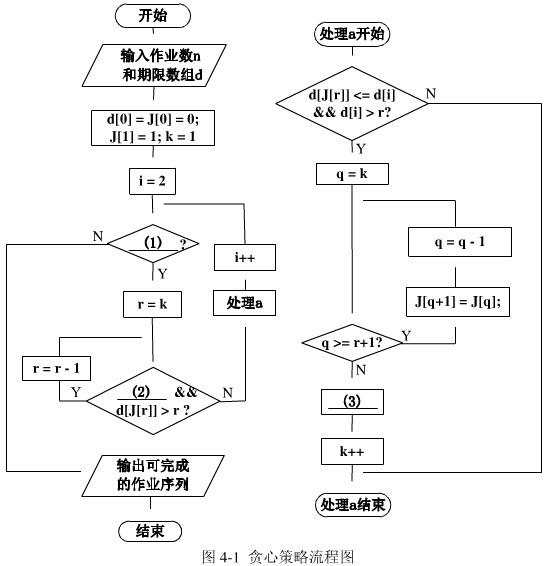【说明】 某机器上需要处理n个作业.job1,job2,…,jobn,其中:
(1)每个作jobi(1≤i≤n)的编号为i,jobi有一个收益值p[i]和最后期限值d[i]小
(2)机器在一个时刻只能处理一个作业,而且每个作业需要一个单位时间进行处理,一旦作业开始就不可中断,每个作业的最后期限值为单位时间的正整数倍; (
3)job1~jobn的收益值呈非递增顺序排列,即p[1)≥P[2]≥…[n);
(4)如果作业jobi在其期限之内完成,则获得收益9[i];如果在其期限之后完成,则没有收益。
为获得较高的收益,采用贪心策略求解在期限之内完成的作业序列。图4-1是基于贪心策略求解该问题的流程图。
(1)整型数组J[]有n个存储单元,变量k众表示在期限之内完成的作业J[1..k]存储所有能够在期限内完成的作业编号,数组J[1..k]里的作业按其最后期限非递减排序,即 d[J[1]]≤…≤d[J[k]]。
(2)为了便于在数组J中加入作业,增加一个虚拟作业Job0,并令d[0]=0,j[0]=0。
(3)算法大致思想:先将作业.job1的编号1放入J[1],然后,依次对每个作业.jobi(2≤i≤n)进行判定,看其能否插入到数组J中。若能,则将其编号插入到数组J的适当位置,并保证J中作业按其最后期限非递减排列;否则不插入。
jobi能插入数组J的充要条件是:jobi和数组J中已有作业均能在其期限之内完成。
(4)流程图中的主要变量院明如下。 i:循环控制变量,表示作业的编号; k:表示在期限内完成的作业数: r:若.jobi能插入数组J,则其在数组了中的位置为r+1: q:循环控制变量,用于移动数组J中的元素。

假设有6个作业job1,job2,…,job6;
完成作业的收益数组p=(p[1],p[2],p[3],p[4],p[5],p[6])=(90,80,50,30,20,10):
每个作业的处理期限数组d=(d[1],d[2],d[3],d[4],d[5],d[6])=(1,2,1,3,4,3)。
请应用试题中描述的贪心策略算法,给出在期限之内处理的作业编号序列()(按作业处理的顺序给出),得到的总收益为()。
参考答案:
(1)1,2,4,5 或job1、job2、job4、job5及其等价描述形式
(2)220
